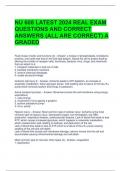NU 608 LATEST 2024 REAL EXAM
QUESTIONS AND CORRECT
ANSWERS (ALL ARE CORRECT) A
GRADED
Fluid mosaic model: and functions (4) - Answer- a mosiac of phospholipids, cholesterol,
proteins, and carbs that float in the fluid lipid bylayer. Allows the cell to protect itself by
altering the number of receptor cells, hormones, bacteria, virus, drugs, and chemicals
that can attach to it.
1. transport molecules in and out of cells
2. facilitate membrane reactions
3. receive chemical messages
4. create structural linkage
Ischemic cell injury 2: - Answer- Ischemia leads to ATP depletion, an increase in
anaerobic metabolism, fewer glycogen stores. Cell swelling due to failure of the Na+/K+
pump which removes sodium and brings in potassium.
Active transport process: - Answer- Movement across the cell membrane using energy
expenditure.
1. uses energy
2. movement of ions against a gradient
3. sodium potassium pump!
4. Ca++ pump!
Hypoxic injury: - Answer- Most common type of cellular injury. Ischemia is the most
common type of hypoxic injury. Decreased oxygen, low hemoglobin, low RBC
production, respiratory disease, cardiovascular disease. Lack of blood flow leads to less
ATP, which causes increased glycolysis, which happens in anaerobic metabolism,
which created lactic acid, leading to acidosis, and destruction of the cell.
Lack of blood flow leads to lack of ATP which is a failure of Na+/K+ pump causing
swelling of the cell and cell death.
Lack of blood flow causes cell membrane damage, calcium moves into the cell and
accumulates causing mitrochondrial damage and cell death.
Most common type of necrosis: other types (4) - Answer- coagulative
1. liquefactive
, 2. caseous
3. fat
4. gangrene
Enzyme leakage: - Answer- Cells contain many intracellular enzymes that catalyze
chemical reactions within the cell. When a cell membrane is compromised, these
enzymes leak from the cell and are present in the ECF.
Enzymes in pancreatitis: - Answer- blood amylase levels, Normal 30-110. Lipase level
0-160
Enzyme in muscle damage: - Answer- creatinine kinase, normal 22-198
Enzyme in liver damage: - Answer- aspartate aminotransferase and alanine
aminotransferase, normal AST 10-40, ALT 7-56.
3 goals of inflammatory response: - Answer- 1. increase blood flow to site (vascular
response)
2. alert the products of healing to respond to site of injury (cellular response)
3. remove injured tissue and prepare site for healing
Important inflammatory mediator: - Answer- Mast cell- cellular bag activated by the
inflammatory response. Release of granules (histamine), synthesis of other mediators
(Leukotrines, prostaglandins, and platelet activating factor)
Most important function of neutrophils: other functions - Answer- phagocytosis
1. chemotaxis
2. margination
3. diapedis
Opsonin: - Answer- Antibody-antigen complex that encourages phagocytosis
Alternative complement pathway: - Answer- FIRST LINE OF DEFENSE. Initiated by
endotoxin, initiating chemotaxis, and functions in the absence of antibody formation.
Hypothermia: - Answer- Drop in temperature below 35C. Disruption of the hypothalamic
thermoregulation function. Heat loss through radiation, conduction, convection, and
evaporation. Shivering increases heat production. Vascoconstriction, increase in
metabolism, ventilation, and cardiac output. Eventually leads to organ failure.
Fever is caused by: - Answer- Interleukin 1, interleukin 6, and TNF, which act on the
hypothalamus and increase the set point.
WHO definition of health: - Answer- a state of complete physical, mental, and social
well-being and not merely the absence of disease or infirmity




